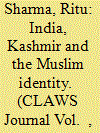| Srl | Item |
| 1 |
ID:
169955


|
|
|
|
|
| Summary/Abstract |
This article is a conceptual review of identifying the factors of the successful implementation of Belt and Road Initiative (BRI) on small-medium enterprises (SMEs) in Malaysia. China’s president Xi Jin Ping has launched the China’s ‘One Belt One Road’ (OBOR) initiative or BRI in 2013. BRI focusses on the connectivity and cooperation between Asian, European and African continents economically and strategically through massive infrastructure developments, trades and investments. BRI is specified to two international trade connections: land-based ‘Silk Road Economic Belt’ and sea-based ‘21st Century Maritime Silk Road’. Malaysia is one of the Southeast Asia countries that actively participated in BRI. According to the World Bank, SMEs are almost 98.5 per cent of business establishments in Malaysia, which undoubtedly indicates how important SMEs are in Malaysia. As such, that is the question to ponder of how BRI could connect and associate with the enhancement and development of Malaysia’s SMEs. Therefore, the objective of the study is to identify the factors of the successful implementation of BRI on SMEs in Malaysia. Based on this study’s literature reviews, it would be suggested that new business and investment opportunity creations, connectivity and cooperation enhancement, trade and export boosting, geographic location and enhancement of e-commerce were the most critical factors in the successful implementation of BRI on SMEs in Malaysia.
|
|
|
|
|
|
|
|
|
|
|
|
|
|
|
|
| 2 |
ID:
139178


|
|
|
|
|
| Summary/Abstract |
Territory has always played a pivotal role in inter-state rivalry. John A Vasquez has said that the value of territories increases due to their strategic locations, such as if they provide access to the sea or are a source of water. But territories acquire another important dimension if they are home to ethnic and religious communities that form part of the neighbouring state.1 The state of Kashmir presents one such enduring conflict where the separatist demands in the state of Jammu and Kashmir (J&K), coupled with the irredentist claim of Pakistan, have helped in shaping a narrative in India. The popular assumption in India is that ‘Muslim separatism’ got manifested in the form of the country’s partition in 1947 and the prevalent contention is that Muslims had a choice of political identity but they chose one based on religion.2 This has resulted in an unintended linking of the Kashmiris’ demand for greater autonomy or a separate state with the identity of Muslims in the rest of India.
|
|
|
|
|
|
|
|
|
|
|
|
|
|
|
|